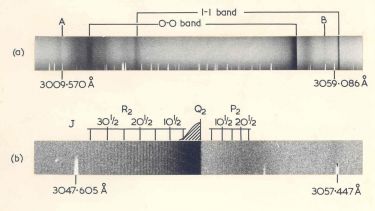Research summary
Sir Harry Kroto's main research areas and research highlights.

Off
Main research areas
- Spectroscopy of unstable species and reaction intermediates (Infrared, Photoelectron, Microwave and Mass Spectrometry)
- Astrophysics (Interstellar Molecules and Circumstellar Dust)
- Cluster science (Carbon and Metal Clusters, Microparticles, Nanofibres)
- Fullerene chemistry, nanoscience and nanotechnology
Research highlights
- first detection of 1Δ state of a polyatomic free radical (NCN by flash photolysis)
- theoretical studies of ground and electronically excited sates of small molecules
- detection of liquid phase intermolecular interactions using Raman Spectroscopy
- breakthrough in the detection of new unstable species (thioaldehydes, thiocarbonyls thioborines) using combination of microwave and photoelectron spectroscopy techniques
- synthesis in 1976 of the first phoaphaalkenes (compounds containing the free carbon phosphorus double bond) in particular CH2=PH (with N P C Simmons and J F Nixon, Sussex)
- monograph “Molecular Rotation Spectra”
- synthesis in 1976 of the first analogues of HCP, the phosphaalkynes which contain the carbon phoshorus triple bond – in particular CH3CP (with N P C Simmons and J F Nixon, Sussex)
- the discovery in 1976-8 of the cyanopolyynes, HCnN (n=5,7,9), in interstellar space (with D R M Walton, A J Alexander and C Kirby (Sussex) and T Oka, L W Avery, N W Broten and J M MacLeod (NRC Ottawa)), Ref 4-6, based on microwave measurements made at Sussex.
- the discovery of C60: Buckminsterfullerene in 1985 (with J R Heath, S C O’Brien, R F Curl and R E Smalley)
- the detection of endohedral metallofullerene complexes (with J R Heath, S C O’Brien, Q Zhang, Y Liu, R F Curl, F K Tittel and R E Smalley)
- the prediction that C60 should be produced in combustion processes and might indicate how soot is formed (with Q L Zhang, S C O’Brien, J R Heath, Y Liu, R F Curl and R E Smalley)
- the explanation of why C70 is the second stable fullerene (after C60) and the discovery of the Pentagon Isolation Rule as a criterion for fullerene stability in general
- the prediction of the tetrahedral structure of C28 and the possible stability of “tetravalent” derivatives such as C28H4
- in 1987 the first prediction that C60 and its analogues such as C60+, endohedral species M@C60, and complexes M.C60, will survive in space and are the best candidates for carriers of the diffuse interstellar bands
- the prediction that giant fullerenes have quasi-icosahedral shapes and the detailed structure of concentric shell graphite microparticles (with K G McKay)
- the mass spectrometric identification and solvent extraction (with J P Hare and A Abdul-Sada) of C60 from arc processed carbon in 1990 – independently from and simultaneously with the Heidelberg/Tucson group
- the chromatographic separation/purification of C60 and C70 and 13C NMR measurements which provided unequivocal proof that these species had fullerene cage structures (with J P Hare and R Taylor, Sussex)
- crystal structure of C60
Main Fullerene chemistry breakthroughs
- C60(ferrocene)2
- characterisation of C60Hal6
- C60(P4)2
Nanoscience and Nanotechnology advances
- condensed phase nanotubes
- nanoscale BN structures
- partly aligned-nanotube bundles
- nanotube formation mechanisms
- silicon oxide nanostructures
- Si surface-deposited fullererene studies
- insulated carbon nanotube conductors
